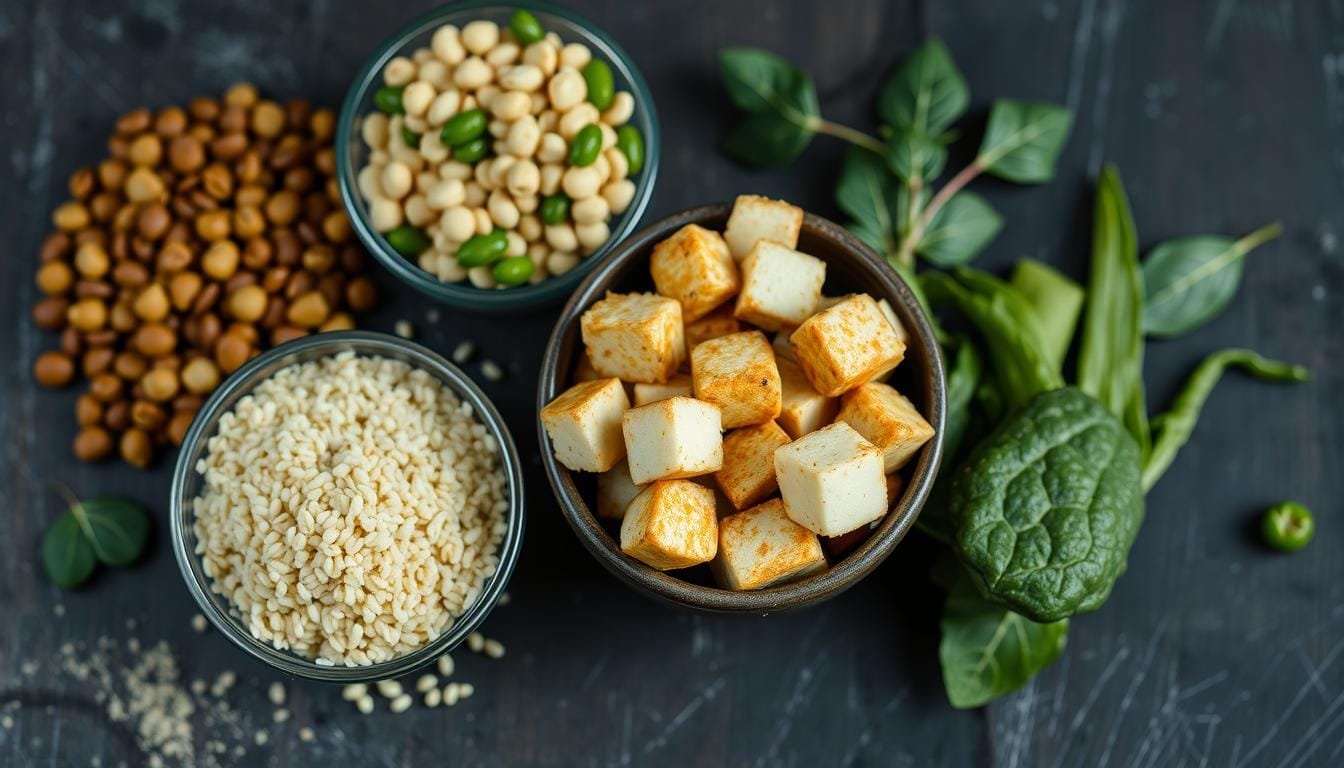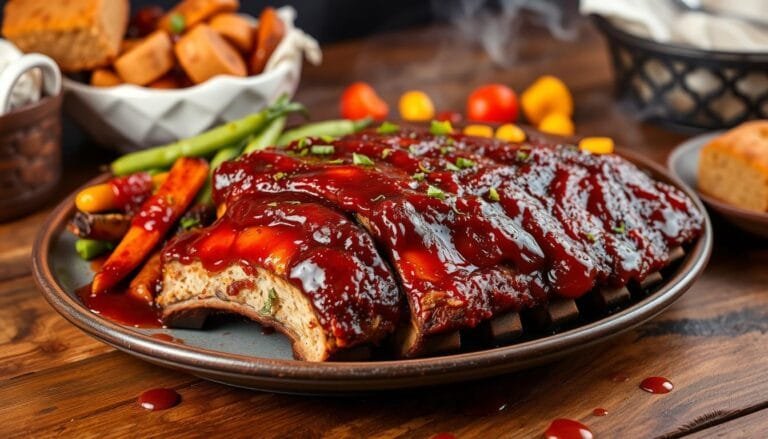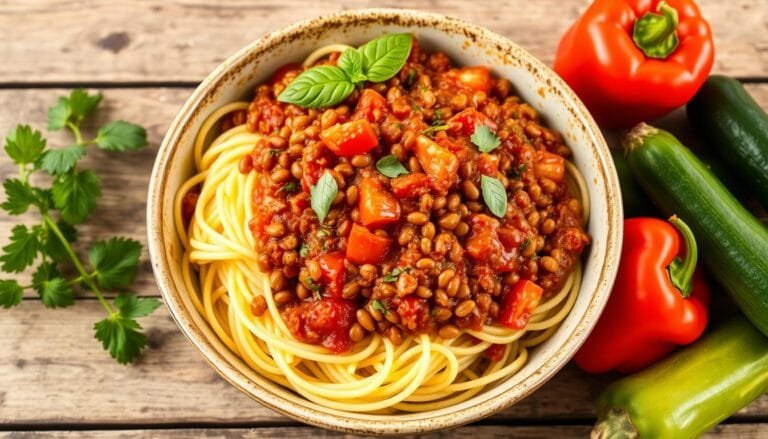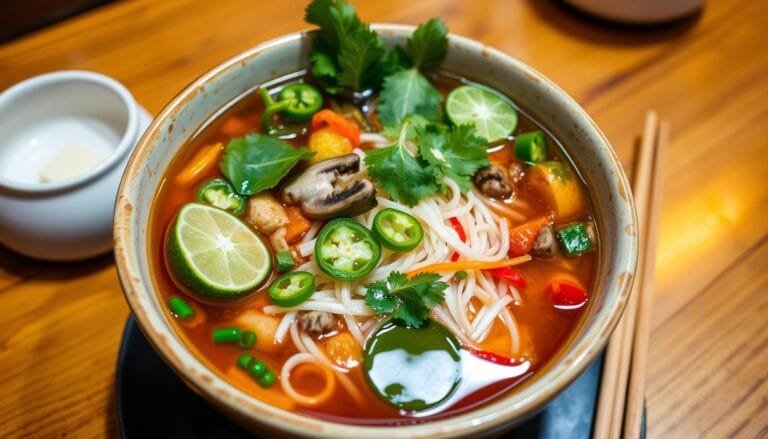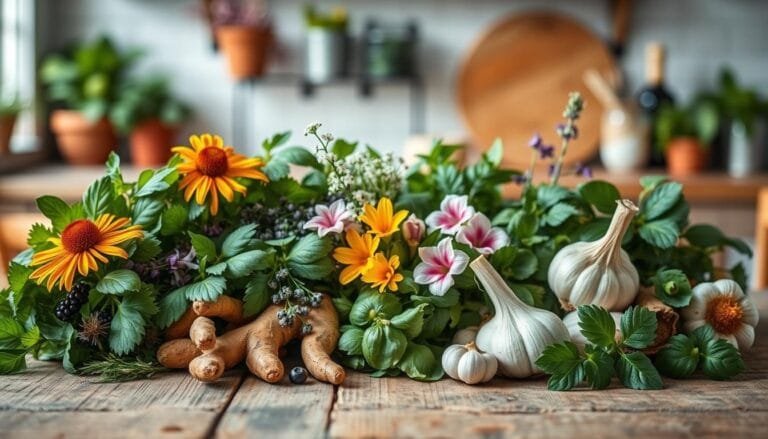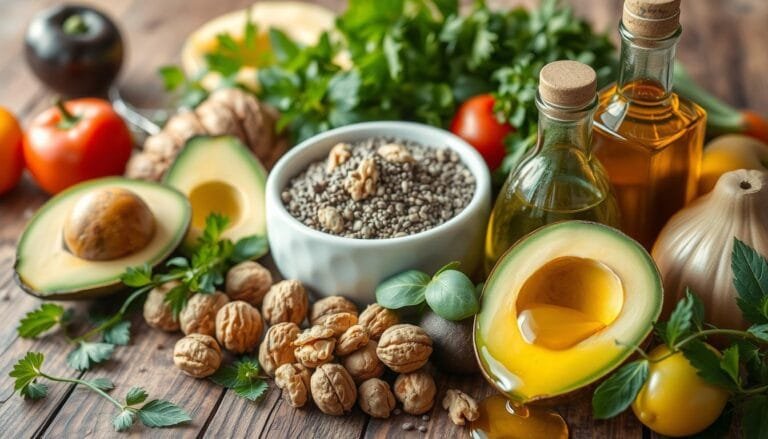I’m passionate about a healthy lifestyle, and I’ve found plant-based protein recipes are key. These meals are not only tasty but also full of natural protein. They help me stay healthy and feel good.
I’ve tried many recipes, like cilantro bean burgers and red lentil soup. They all have over 15 grams of protein. Using black beans, lentils, tofu, and quinoa makes these meals satisfying and nutritious.
Discovering high-protein vegan recipes has changed my life. I’m eager to share my findings and encourage others to try plant-based protein for their health.
Understanding the Power of Plant-Based Proteins
Plant-based proteins can change your health journey for the better. They are lower in saturated fat and higher in fiber. This helps your heart and aids in weight control. Plus, they’re better for the planet, making them a smart choice.
Benefits of Plant Proteins for Overall Health
Plant proteins are great for fighting inflammation and helping muscles recover. Lentils, for example, have about 18 grams of protein per cup. Spinach, surprisingly, has around 5 grams per cup. Eating more plant proteins can improve your heart health and help you manage your weight.
Common Misconceptions About Plant Protein Sources
Many think plant proteins are not enough or not complete. But, a vegan diet can give you all the amino acids you need. Quinoa, for instance, is a complete protein with all nine essential amino acids. Plant protein powders like pea, hemp, and brown rice are also good for adding protein without animal products.
Essential Amino Acids in Plant-Based Foods
Plant-based diets can give you all the amino acids you need. Legumes, grains, nuts, and seeds are full of these proteins. Mixing different plant proteins, like rice and beans, ensures you get all the amino acids. Plant-based proteins are tasty, healthy, and good for the planet.
“A well-planned vegan diet can provide all the essential amino acids your body needs.”
Essential Kitchen Tools and Ingredients for Plant-Based Cooking
Starting a vegan or plant-based diet means having the right kitchen tools and ingredients. I’ve gathered a list of must-haves that are key to my vegan pantry and kitchen. These items are the foundation of my cooking.
Versatile Kitchen Gadgets
- High-speed blender for making smoothies, sauces, and nut butters
- Food processor for shredding, chopping, and pureeing ingredients
- Non-stick cookware for easy meal prep and less cleanup
- Spiralizer for making zucchini noodles and other veggie dishes
Pantry Staples for Plant-Based Cooking
- Legumes (lentils, chickpeas, black beans, pinto beans) for protein
- Whole grains (quinoa, brown rice, farro, bulgur) for carbs
- Nuts and seeds (almonds, cashews, chia, flax) for healthy fats
- Nutritional yeast for a cheesy flavor in vegan dishes
- Tahini, soy sauce, and spices for bold flavors
- Canned or jarred items like diced tomatoes, coconut milk, and nut butters for convenience
| Ingredient | Recommended Brands |
|---|---|
| Coconut Aminos | Coconut Secret, Big Tree Farms |
| Hot Sauce | Frank’s RedHot |
| Almond Butter | Good & Gather, Trader Joe’s, 365 by Whole Foods |
| Curry Paste | Thai Kitchen |
| Coconut Milk | Thai Kitchen (lite and full-fat) |
With these vegan pantry staples and plant-based kitchen essentials, you’re ready to cook a variety of vegan dishes. You’ll have all the tools and ingredients you need.
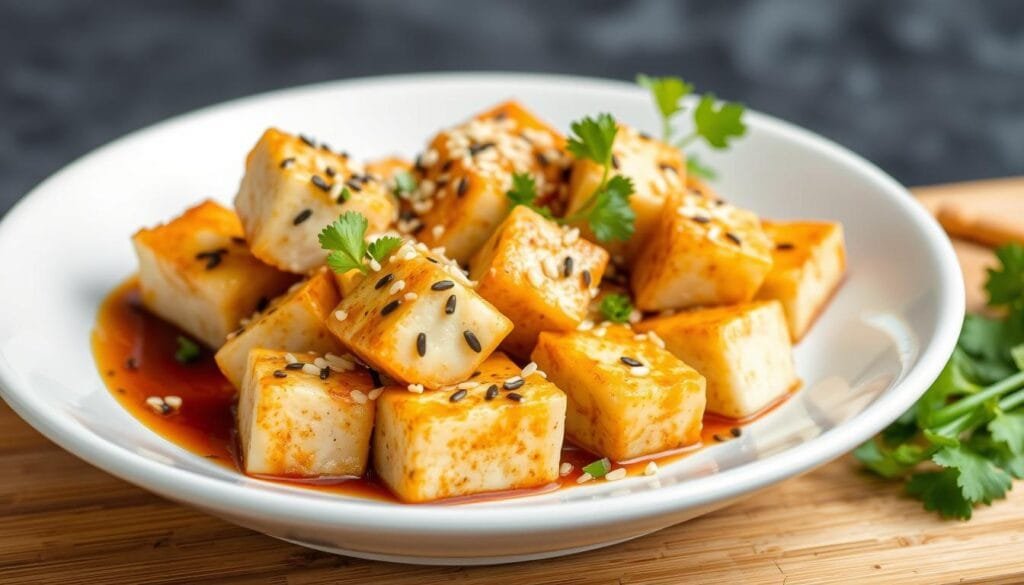
Quick and Easy High-Protein Breakfast Ideas
Starting your day with a protein-packed breakfast is a great way to fuel your body. It keeps you feeling satisfied until lunchtime. As a vegan, you can easily achieve a high-protein breakfast with plant-based ingredients. Try smoothies, savory breakfast bowls, and make-ahead meal options. These recipes are nutritious and delicious, making you energized and ready for the day.
Protein-Packed Smoothie Recipes
Blending up a high-protein smoothie is a quick and easy breakfast option. Mix plant-based protein powder, chia seeds, and nut butters for a nutrient-dense start. For example, a smoothie with 1/2 cup organic soy milk, 1/2 cup old-fashioned oats, 2 tablespoons pumpkin seeds, 1/3 cup berries, 1/2 banana, and 1 tablespoon natural peanut butter gives you 21.9 grams of plant-based protein.
Savory Breakfast Bowl Combinations
Savory breakfast bowls offer a hearty and filling vegan breakfast. Try a tofu scramble with sautéed veggies, quinoa, and avocado for a protein-rich meal. For a Mexican-inspired bowl, layer black beans, Just Egg, salsa, and whole grain tortillas for a delicious start to your day.
Make-Ahead Breakfast Options
Preparing breakfast in advance can save you time. It ensures you have a high-protein meal on hand. Whip up a batch of overnight oats with chia seeds, peanut butter, and berries for a grab-and-go breakfast. You can also make breakfast burritos with plant-based egg substitutes, black beans, and whole grain tortillas to reheat throughout the week.
By incorporating these vegan breakfast recipes, high-protein smoothies, and make-ahead meal prep strategies, you can enjoy a nourishing and satisfying plant-based start to your day.
Plant-Based Protein Recipes for Lunch and Dinner
Adding plant-based proteins to your meals can be fun and healthy. You can make everything from hearty lentil soups to tasty tofu stir-fries. These vegan lunch ideas and plant-based dinner recipes are endless. Let’s dive into some high-protein meals that will keep you full and energized.
The Chickpea Avocado Salad Sandwich is a favorite vegan lunch idea of mine. It’s creamy and packed with protein, thanks to chickpeas, avocado, and herbs. It gives you about 15 grams of plant-based protein. For dinner, try the Quinoa and Black Bean Bowl. It has around 18 grams of protein from quinoa and beans.
Want to try something different? The Five-Spice Tofu Crumble with Whole Wheat Noodles and Almond Butter Sauce is a great choice. It has 37 grams of protein per serving. Or, for a cozy plant-based dinner recipe, the Curried Lentil and Sweet Potato Bowl is perfect. It has 30 grams of plant-based protein.
“Eating a variety of plant-based protein sources not only supports overall health but also adds delicious diversity to your meals.”
Whether you’re craving a quick lunch or a fancy dinner, these vegan lunch ideas and plant-based dinner recipes have you covered. They offer plenty of high-protein meals to nourish your body and please your taste buds.
Legume-Based Dishes for Maximum Protein Content
Legumes are the stars of plant-based protein. They include lentils, beans, and chickpeas. These foods are full of nutrients and can be used in many ways.
Creative Ways with Lentils and Beans
Lentils and beans are full of protein, fiber, and nutrients. Try making lentil loaves, bean burgers, or three-bean salads. These dishes are not only protein-rich but also show how versatile legumes can be.
Mediterranean-Inspired Chickpea Recipes
Chickpeas are key in Mediterranean cooking. Make falafel, hummus, or chickpea curry for a protein-rich taste. These recipes are tasty and full of nutrients.
Protein-Rich Soup Variations
Soups are great for adding plant-based protein and warmth. Try lentil, vegetable, bean, or minestrone soups. These soups are nutritious and perfect for any time of year.
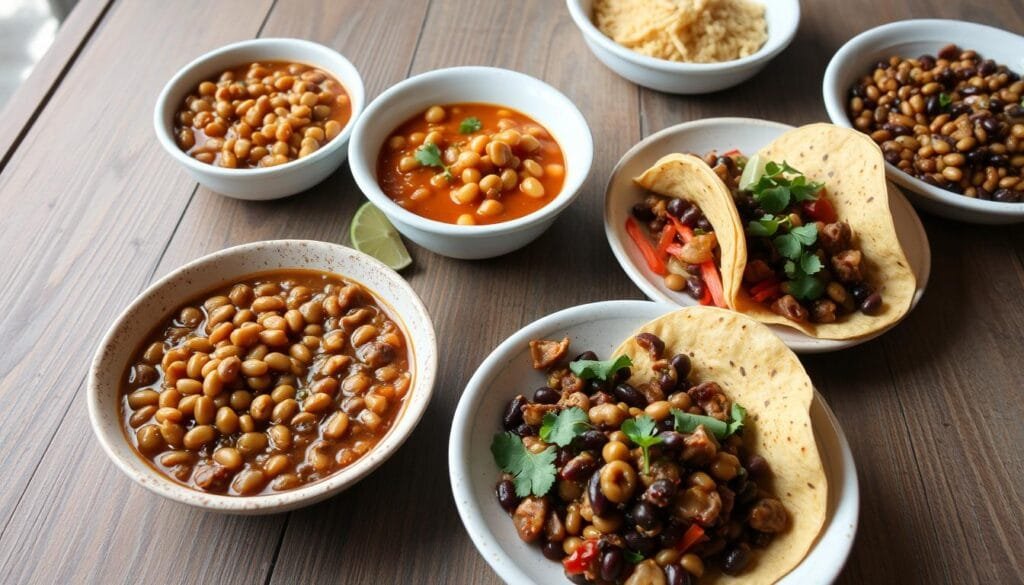
“Legumes are a true superfood, providing an array of essential nutrients and an abundance of plant-based protein. Incorporating them into your meals is a simple way to elevate your health and satisfaction.”
Using legumes in your cooking can make your meals both tasty and nutritious. Try out these legume recipes and discover a world of protein-rich dishes.
Tofu and Tempeh Preparation Techniques
Tofu and tempeh are great plant-based proteins for many tasty dishes. They can be used in various ways, from tofu recipes to tempeh cooking. These soy-based foods are perfect for adding protein to your meals.
Preparing Tofu
Tofu is like a blank canvas, ready to soak up flavors. To get the right texture, press the tofu first. Wrap it in a towel or paper towels and weigh it down for 15-30 minutes.
After pressing, you can bake it for a crispy outside, pan-fry for a golden crust, or scramble it like eggs.
Cooking with Tempeh
Tempeh is a firm, chewy soy cake. It’s great for slicing, marinating, and grilling. Just slice it, marinate it, and then cook it.
It’s also a good ground meat substitute in dishes like chili or tacos.
With a bit of creativity, tofu and tempeh can be the main attraction in your meals. Try crispy baked tofu or marinated tempeh steaks for a flavorful, healthy dish.
Tofu and Tempeh Recipes
- Crispy Baked Tofu
- Tofu Scramble
- Marinated Tempeh Steaks
- Tempeh Bacon
“Tofu and tempeh are like blank canvases waiting to be transformed into delicious, protein-packed meals.”
Quinoa and Ancient Grains as Protein Sources
Quinoa and ancient grains like amaranth, millet, and farro are packed with plant-based protein. They can make your meals protein-rich and delicious. You can use them in grain bowls, one-pot dishes, and salads, making your diet exciting.
Grain Bowl Combinations
Begin your day with a protein-rich quinoa grain bowl. Mix cooked quinoa with roasted veggies like sweet potato, broccoli, and chickpeas. Add a miso-tahini dressing for extra flavor. These bowls are filling and keep you energized all day.
One-Pot Grain Recipes
For a quick dinner, try quinoa or farro one-pot recipes. Make a quinoa chili with beans, tomatoes, and spices. Or, enjoy a creamy farro risotto with mushrooms and onions. Both are comforting and protein-rich.
Ancient Grain Salad Ideas
Salads with quinoa, farro, and barley are nutritious and filling. Mix the grains with roasted veggies, fresh herbs, and a tasty dressing. Ancient grains’ nutty flavors complement many ingredients, making them great for your meals.
| Grain | Protein Content (per cooked cup) | Fiber Content (per cooked cup) |
|---|---|---|
| Quinoa | 8 grams | 5 grams |
| Farro | 7 grams | 6 grams |
| Amaranth | 9 grams | 5 grams |
| Millet | 6 grams | 2 grams |
Discover the nutty, earthy tastes of quinoa recipes, ancient grains, and high-protein grains. They offer plant-based nutrition and delicious flavors.
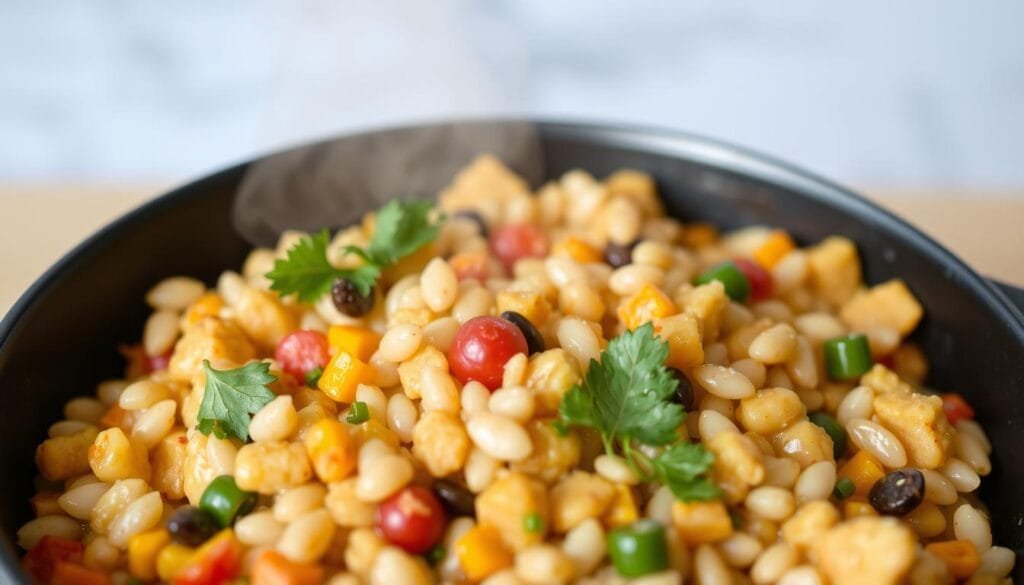
Protein-Rich Snacks and Small Bites
Staying energized and supporting muscle health between meals is key. Protein-rich vegan snacks and small bites are perfect. From homemade energy balls to savory roasted chickpeas, there’s plenty of tasty, nutritious options. Let’s look at some top high-protein appetizers and vegan snacks for a healthy lifestyle.
One favorite of mine is edamame hummus with vegetable sticks. Edamame, a soybean, is high in plant-based protein, with 8 grams per half-cup. This dip with carrots, bell peppers, or cucumber is both nourishing and satisfying.
Roasted chickpeas are another favorite. These legumes are rich in fiber and protein, with 7 grams in a half-cup. Seasoned and baked, they’re a crunchy snack that beats potato chips.
- Homemade energy balls with nuts, seeds, and dried fruit offer up to 6 grams of protein per ball. They’re a great, portable snack.
- Nut butter with apple or pear slices is creamy and satisfying. It’s a mix of protein, healthy fats, and fiber.
- Tempeh strips or tofu-based dips are also great high-protein appetizers.
Looking for a pre-workout snack or a pick-me-up? These protein-rich vegan snacks will keep you fueled and energized all day.
| Snack | Protein Content |
|---|---|
| Beef jerky | 9 grams per ounce |
| Trail mix | 8 grams per 2-ounce serving |
| Turkey roll-ups | 12 grams per wrap |
| Greek yogurt parfait | 20 grams per 200-gram serving |
| Tuna | 20 grams per 3-ounce serving |
| Hard-boiled egg | 6 grams per egg |

“Embrace the power of plant-based proteins to fuel your body and fuel your day. Snacking has never been so delicious and nutritious!”
Meal Prep Strategies for Plant-Based Eating
Starting a vegan or plant-based diet can be easy with the right meal prep. Spend a few hours on the weekend or week to fill your fridge and freezer with healthy, protein-rich vegan meals and snacks.
Weekly Prep Guidelines
Begin by prepping basic ingredients like cooked grains, legumes, and chopped veggies. This makes it simple to make power bowls, salads, or other plant-based dishes all week. Cook big batches of quinoa, brown rice, lentils, or chickpeas to have ready.
Storage and Freezing Tips
Keeping your vegan meal prep fresh and good is all about proper storage. Use airtight containers in the fridge and label and date everything. Many vegan proteins and meals freeze well, from stews to vegan meatballs.
Batch Cooking Methods
Batch cooking saves time and effort. Make big batches of soups, casseroles, or chilis to freeze for quick meals. Vegan baked goods like muffins or cookies also freeze well for snacks.
With these meal prep tips, you can easily keep a consistent, protein-rich plant-based diet. Enjoy the ease of having healthy, tasty vegan meals ready whenever you need them.
Nutritional Information and Portion Guidelines
Keeping a balanced plant-based diet is key. Knowing about nutritional information and portion sizes is important. Adults need about 0.8 grams of protein for every kilogram of body weight. Luckily, plant-based foods can meet this need easily.
I make sure to mix legumes, grains, veggies, and healthy fats in my meals. Beans or lentils give up to 18 grams of protein per cup. Tofu or tempeh can offer 20-34 grams. Even spinach adds 5 grams of protein per cup when cooked.
Remembering portion sizes helps me plan meals. My main dishes usually have 15-30 grams of protein. This keeps me full and energized all day. Following these guidelines helps me stay healthy and balanced.
